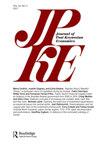产出缺口、参与率和最低收入:给意大利的建议
IF 1
3区 经济学
Q4 ECONOMICS
引用次数: 0
摘要
最近,一些试图在欧洲预算框架中增加财政政策立场的尝试遵循了降低估计的“结构性”失业率(NAIRU)的路线,随之而来的是增加产出缺口的计算。通过提高实际参与率可以获得类似的效果。在本文中,我们建议引入赤字融资的有条件最低收入(CMI),以鼓励劳动力之外的气馁人群。通过刺激参与,这一措施将使意大利的潜在产出向上修正,而这反过来将有助于形成更大的财政立场。我们通过使用比较静力学和通过欧盟委员会产出差距工作组使用的模拟程序进行的经验估计来经验性地评估这一措施的可靠性。假设有100万新劳动力,我们的研究结果表明,该措施将在2016年产生约190亿欧元的财政空间,在2017年产生120亿欧元的财政空间。我们还预测了引入赤字融资CMI对实际GDP和公共财政指标的影响。我们最后讨论了该建议的可行性和主要批评。本文章由计算机程序翻译,如有差异,请以英文原文为准。
Output gap, participation and minimum income: a proposal for Italy
Abstract Recently, some attempts to increase the stance for fiscal policies in the European budgetary framework have followed the line of reducing the estimated “structural” unemployment rate (NAIRU), with the ensuing increase in the computation of the output gap. A similar effect can be obtained by increasing the actual participation rate. In this paper, we propose the introduction of a deficit-financed conditional minimum income (CMI) to discouraged people which are outside the labor force. By stimulating participation, this measure would bring about an upward revision of Italy’s potential output, and this in turn will contribute to generate a greater fiscal stance. We empirically assess the reliability of this measure by using both comparative statics and empirical estimations carried out via the simulation procedure used by the Output Gaps Working Group of the European Commission. Assuming one million newcomers in the labor force, our findings indicate that the measure would have produced a greater fiscal space of approximately €19 billion in 2016 and €12 billion in 2017. We also forecast the impact of the introduction of the deficit-financed CMI on real GDP and public finance indicators. We finally discuss the feasibility and the main criticisms of the proposal.
求助全文
通过发布文献求助,成功后即可免费获取论文全文。
去求助
来源期刊

Journal of Post Keynesian Economics
ECONOMICS-
CiteScore
1.70
自引率
10.00%
发文量
23
期刊介绍:
The Journal of Post Keynesian Economics is a scholarly journal of innovative theoretical and empirical work that sheds fresh light on contemporary economic problems. It is committed to the principle that cumulative development of economic theory is only possible when the theory is continuously subjected to scrutiny in terms of its ability both to explain the real world and to provide a reliable guide to public policy.
 求助内容:
求助内容: 应助结果提醒方式:
应助结果提醒方式:


